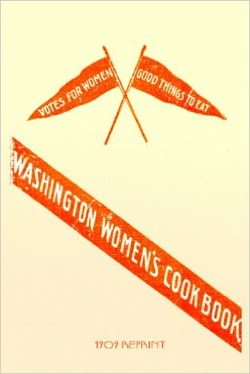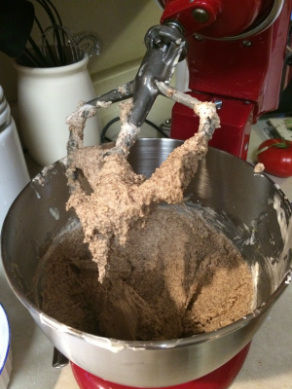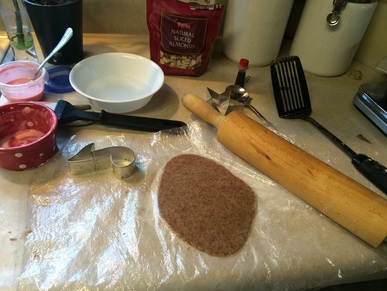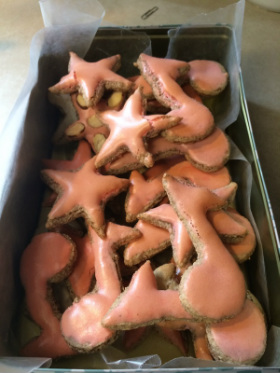With publication of this cookbook in 1909, the Washington Equal Suffrage Association followed in the footsteps of a handful of other suffrage cookbooks; the first was the Woman’s Suffrage Cook Book, published in 1886 by the Massachusetts Woman Suffrage Association. They in turn were imitating charity cookbooks published after the Civil War.
Suffrage cookbooks served a number of purposes. In addition to plumping up suffrage coffers, they also helped spread the word about their cause. A third purpose was to allay concerns: giving females the vote would not bring about the collapse of hearth and home. Vote, bring home the bacon, fry it up in a pan? You bet – it’s all in a day’s work of complementary tasks:
What is politics? Why, it’s housekeeping on a big scale. The government is in a muddle, because it has been trying to do the housekeeping without the women.
~Washington Women’s Cook Book, p. 41
Reicpes in the Washington Women’s Cook Book run the gamut from simple to challenging. On one end of the easy/difficult spectrum:
To Boil Water Without Burning.
To boil water without burning is a clever thing to do. Water to be palatable and healthy should only just come to a boil; that is, to the boiling point, then set aside, where it can be kept at this point until wanted for use. Water that is kept boiling soon losses [sic] its best flavor in the evaporation, and this leaves the old burnt material in the teakettle, and such water is not fit to drink.
Mrs. Jennie Jewett, White Salmon.
~Washington Women’s Cook Book, p. 186
Looking for something a bit more flavorful, I made the following for my daughter’s grad school voice recital reception last spring. We had several treats planned, but I still needed something sweet that was also gluten-free. Then I remembered seeing this recipe for a traditional German cookie. It was an opportunity I couldn’t pass up – a recipe from an old suffrage cookbook, gluten-free, and German. (The German part was a shout-out to my heritage and to another daughter, who was then having a grand time studying in Münster.)
Zimmersterne (Cinnamon Stars)
Whites of two large eggs, one-half pound of powdered sugar, one-half pound of unblanched almonds, chopped very fine or ground, one spoonful of cinnamon, grated rind of half a lemon. Beat the eggs to a stiff froth. Stir eggs and sugar together for fifteen minutes. Add almonds and small pinch of baking powder. Roll out about one-half inch thick. Cut in stars or small fancy shapes.
~Washington Women’s Cook Book, p. 172
Also factoring into my decision to try the recipe – it didn’t look too hard. I love to bake, but time was growing short and (more to the point), I don’t think I’ll ever be a contestant on The Great American Baking Show.
To save time, I bought Bob’s Red Mill Super-Fine Almond Flour instead of grinding my own. It also meant I couldn’t over-process the almonds and end up with almond butter.
At some point, I noticed a shortcoming in the instructions – where’s the temp and the baking time? I know next to nothing about wood-burning stoves, but imagine there was some difficulty in standardizing temps back in the day. But still.
Thankfully, here in the twenty-first century, we have the Internets to turn to, so I thought the matter would soon be settled. Not exactly. I found Zimmersterne recipes calling for 300, 325, and 375 degrees. Baking times ranged from 6-8 minutes to 12-15 and even 20-25 minutes. AACK. I am such a rule-follower with recipes – at least the first time I try something. This lack of clarity unnerved me, but I pressed on anyway.
The dough is quite sticky and should definitely be chilled before rolling. As one recipe advised, put it in the fridge and then, “Sit down, relax and have a cup of tea.” Good advice, and not just when baking, wouldn’t you say? Other helpful suggestions: sprinkling powdered sugar to help minimize sticking and rolling between parchment paper.
Unfortunately, what I don’t recall now is how long I baked them. I think I baked them at 325 and for 12-15-ish minutes, but please don’t quote me on that. Here are the main recipes I consulted at the time: BBC Good Food, Food.com, and All Recipes.




 RSS Feed
RSS Feed